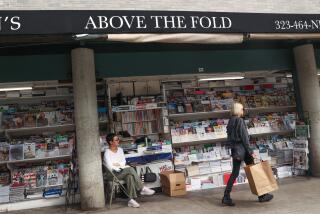For newspapers, outlook is not black and white
You think the economy is sending mixed signals? Just look at the newspaper industry.
For every âgreen shootâ that appears, thereâs a tumbleweed or two rolling by next door.
On the positive side, advertising sales firmed a bit in June at major chains such as Gannett Co. and New York Times Co., enabling those companies to post unexpectedly strong second-quarter profits. Newspaper stocks rallied sharply -- Gannett shares have rocketed 156% since the end of June -- as some investors bet that aggressive cost cutting has positioned the companies for higher profit once the economy rebounds.
Publishers are finally talking seriously about charging for the online content they now offer for free. And small-town daily and weekly papers are holding their own even as many of their big-city brethren struggle.
Read between the lines, though, and the news isnât so upbeat. At most papers, profit growth was driven mostly by cost cutting, not higher revenue from selling more ads or increasing circulation. Reaching into the wallets of the 70 million people who visited newspaper websites in June sounds lucrative, but publishers are still debating how to do that without alienating readers.
And that stock rally? Despite the recent run, Gannett shares are worth half what they were a year ago, and the U.S. economy is flashing conflicting signals about the prospects for a robust recovery.
Failures continue to loom. Freedom Communications Inc., operator of the Orange County Register, is expected to declare bankruptcy this week, according to a Wall Street Journal report Sunday that quoted people familiar with the situation. It would be the latest in a string of bankruptcies, including that of Los Angeles Times owner Tribune Co.
These crosscurrents come only months before the crucial holiday shopping season, which in good times portends papers fat with department store ads. This year, however, the holidays are shadowed by fears that the worst economic downturn in decades will keep shoppers out of stores -- and retail ads out of newspapers.
If advertisers do ramp up spending, analysts will be watching for answers to a crucial question: How much of the advertising decline of the last two years has been due to the economic downturn, and how much has migrated to the Internet, never to return?
âThis is an important time for the newspaper industry,â said Brad Adgate, senior vice president of research for Horizon Media Inc., an ad services firm. âTheyâll get some of that advertising back, but how much, only time will tell.â
Of course, any good news would be welcome for an industry that has had its share of troubles lately.
The double-whammy of recession and the loss of advertising to Google Inc., Craigslist and other online competitors has been devastating. Tens of thousands of jobs have been lost to cost cutting, and ad sales have gone into a tailspin, falling almost 18% in 2008 -- the third straight annual decline. Big city papers such as Denverâs 149-year-old Rocky Mountain News have gone under or, in the case of the Seattle Post-Intelligencer, switched to online-only editions.
âThere are signs that there might be some improvement, but so far itâs not very widespread and not very solid,â said John Morton, a longtime newspaper analyst. âFrom an operating standpoint, this is going to be a very tough year.â The most recent evidence came last week when the Newspaper Assn. of America reported that newspaper print advertising fell 30% in the first half of 2009.
Big âdisplayâ advertisers such as department stores and movie studios may return in force when the economy revives. But classified ads, which used to account for more than half the revenue at metropolitan papers, Morton said, probably will never be the cash cow they once were.
Online sites have grabbed huge swaths of the job listings, real estate ads and auto classifieds that once buoyed daily papers.
âThe Internet is a much more powerful vehicle for the sales of automotive, real estate and employment advertising than anything you can do in print,â said Larry Grimes, a newspaper broker with media investment bank W.B. Grimes & Co.
In contrast to larger papers, small-town dailies and weeklies are holding their own these days. Most small papers never depended much on the classified ads that their larger brethren are losing to the Internet. And local stores are more likely to reach their customers through ads in the local paper than through the Internet, said Nancy Lane, president of Suburban Newspapers of America, the trade group for about 2,000 community papers.
âMaybe someday the Internet will find a way to get to that hyper-local level but so far it hasnât,â Lane said, âand for the local mom-and-pop retailer, the community paper still provides the best return on their investment.â
Laneâs group reported a 3.6% drop in ad revenue last year compared with a nearly 18% drop for all newspapers.
Local papers that once routinely covered their front pages with wire versions of the same stories big-city papers were covering are now focusing almost exclusively on covering local news, Lane said.
âOur value is delivering news that nobody else is reporting on,â said Anthony Allegretti, chief executive of MainStreet Media Group of Gilroy, Calif., which owns a chain of weekly and semiweekly papers around California, including the La Jolla Light and the Solana Beach Sun in San Diego County.
âNobody else has boots on the street to gather the news and sell the ads the way we do,â Allegretti said.
John Kent Cooke, whose dad once owned the Daily News as well as the Los Angeles Lakers and Kings, clearly is a believer in the âsmall is beautifulâ school of journalism. Last month, Cooke bought 13 daily and weekly papers in North Carolina to add to his string of small Florida papers, which includes the Key West Citizen.
âWhat I realized is that these papers will thrive on local news,â Cooke told the Washington Post. âThe key to the whole thing is content.â
The bosses at the big metro dailies couldnât agree more. One way to replace that lost revenue would be to make money off the news, commentary and analysis their newspapers now provide free online.
In recent months, several companies, including New York Times and MediaNews Group, owner of the Daily News and several other California papers, have said they were exploring ways to charge users for at least some of their publicationsâ online content.
At least one small paper is taking a different approach. Rather than provide a full version of its paper online, the Antelope Valley Press in Palmdale offers only headlines and brief news summaries on its website. The full articles are available only in the hard-copy version of the paper.
This month, the Los Angeles Times reported that Rupert Murdochâs News Corp., which owns a stable of newspapers that includes the Wall Street Journal and the New York Post, is talking with other publishers about forming a consortium that would collect fees for the Web-based news products.
Some analysts question whether such schemes will ever generate significant revenue for newspapers. They could also face antitrust scrutiny from Washington.
Without significant dollars from online users, large newspapers will have to look for other sources of revenue while learning to live with the smaller budgets that go along with a thinner slice of the advertising pie. It may be cold comfort for the ranks of unemployed journalists, but investors may find that combination a recipe for future profits.
John Rogers Jr. of Chicago-based Ariel Investments, which has substantial holdings in publishers such as Gannett and Sacramento-based McClatchy Co., thinks the newly slimmed-down newspapers will rebound along with the U.S. economy.
âWhen the economy recovers, traditional advertisers will come back,â he said. âThey might not come back to where they used to be, but weâve had so much cost cutting that even with only a modest rebound, the earnings potential is really going to surprise people.â
--
More to Read
Inside the business of entertainment
The Wide Shot brings you news, analysis and insights on everything from streaming wars to production â and what it all means for the future.
You may occasionally receive promotional content from the Los Angeles Times.










